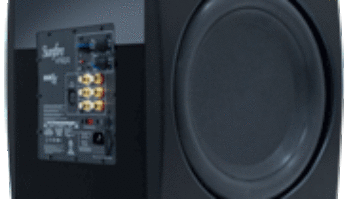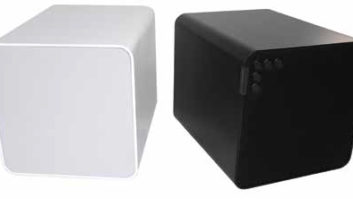I’m seriously considering writing a sort of stock template for future Sunfire subwoofer reviews, just to save time down the road. Maybe start off with the standard boilerplate fluff about how standalone subwoofers are typically big, boxy, unappealing affairs. Maybe drop in a cliché about subs the size of coffee tables. That always seems to play well. Segue from there into a discussion about the general consensus that you need large drivers to really move massive amounts of air.

Sunfire’s latest subwoofer, the Atmos, stands out in a crowded subwoofer market.
Tired, I know. The thing is, the Sunfire subwoofers that I’ve signed for and schlepped across my threshold as of late have so beautifully deviated from this norm that it’s hard not to fall into worn-out truisms when discussing what sets them apart. See my review of the company’s SRS- 210R SYS SubRosa Flat Panel Subwoofer System (Residential Systems August 2011) as an example.
So, how does Sunfire’s latest effort–the Atmos– stray off the beaten path? Actually, by heading down a road that a lot of subwoofer manufacturers have trampled lately: that of the mini sub. There are quite a few high-profile subwoofer manufacturers packing a whole lot of oomph into itty bitty packages these days. And many of them sound surprisingly great.
The thing is, though, after hooking up the Atmos (whose appelation is a little unfortunate, by the way, given Dolby’s recent introduction of its identically named 64-speaker cinema surround sound system), the first comparison that came to my mind wasn’t another mini sub. No, the sound that I immediately thought of was that of the biggest sub I’ve ever heard: Wisdom Audio’s STS Subwoofer. And no, I don’t mean to imply that the Atmos’s output is comparable to the 130dB at 20 Hz of Wisdom’s 5,000-watt, 22-cubic-foot monster. I just mean that the quality of the sound is strikingly similar–that “holy crap, this is a lot of robust bass, but it doesn’t really sound like a subwoofer” kind of sound. The distortion that you typically associate with–and accept from–most subs simply isn’t there. It’s like a well-behaved child that draws attention to himself by not drawing attention to himself. It integrates so beautifully with the rest of my system.
I also don’t mean to imply that Atmos is capable of the same subterranean depths as the STS. Its useable bass extension rolls off at about 30Hz. So, if I’m being completely objective here, I have to admit that, in the final battle scenes from The Incredible Hulk on Blu-ray, although the Atmos pumps out every ounce of the Fe, Fi, and Fo, I do miss a little of the Fum that I’m used to from the film. You still feel every hit. The thump is absolutely massive. The only thing that’s missing is just a bit of the very deepest growl.
But let’s stop for a moment and reflect upon the fact that a tiny little cube that I can hold in the palm of my hand, with two itty-bitty 6.5-inch drivers, can crank out 30Hz bass in my 13-by-15-foot secondary listening room. Okay, I’m fibbing a little about being able to hold the Atmos in one hand. Not that it doesn’t fit, but this little bugger has roughly the same density as a neutron star. It weighs 32 pounds, despite measuring only 8.5×8.9×10.1 inches. To put that in perspective, it’s significantly heavier than my GoldenEar ForceField 3, which boasts an 8-inch driver, a 9×11-inch passive radiator, and a 1,000- watt amp.
I have to think most of that weight comes from the Atmos’ own 1,400- watt beast of an amp, which features Sunfire’s Tracking Downconverter technology for cool operation. That, I think–in addition to its design–is what allows this little monster to pump out such robust bass. Aside from that one scene in The Incredible Hulk, I never feel like I’m missing a thing. The opening fly-by of Queen Amidala’s silvery ship in Star Wars: Episode II? Foom! The battle sequences in The Two Towers and Return of the King? Boom! It also sounds positively dynamic and articulate with music, from the loping bass guitar lines of “Hotel California” on DVD-A to the throbbing bottom end of Kayne West’s “Love Lockdown” to the all-over-the-map rumble of a Blue Man Group drum line.
The one caveat I have is that, in my room, I’m pushing a solitary Atmos to its limits. And by that, I mean that the volume knob is pegged. Even at that, though, it doesn’t strain in the slightest. “Effortless” is the word that keeps coming back to mind. Thankfully, Sunfire has made pairing a couple of Atmos subs a snap. In addition to its pair of outputs (along with a 12-volt trigger input), it has main and slave audio inputs, and you can calibrate two subs at a time with Sunfire’s built-in auto EQ. In the end, I have to admit that I preferred using the Anthem Room Correction of my MRX 700 receiver to tune the sub, but the built-in EQ does an admirable job, nonetheless, and may prove a superior solution if the room correction software you’re using doesn’t handle bass as well as ARC.
So, needless to say, even if I do create a template for future Sunfire subwoofer reviews, the middle bits are still going to require some work. The company continues to develop products that quite frankly astound me with their inventiveness. I do think I’m safe in cooking up a standard exclamatory conclusive sentence, though. Something along the lines of…
Sunfire’s latest effort seriously stands out in a crowded subwoofer market, with a unique design and truly amazing performance.
760.710.0993
sunfire.com
Kudos
Despite a footprint similar to so many mini subs that have hit the market lately, the Atmos generates the quality of bass you would expect from much, much larger subwoofers. Even when pushed to its limits, it doesn’t struggle a bit. And its generous inputs and outputs also lend to an amazing amount of flexibility in installation.
Concerns
I wouldn’t call it a concern, exactly, but you should be aware that the Atmos’s usable bass extension rolls off at around 30Hz, and in anything larger than a smallto mid-sized den, you’ll need at least two of them.
Product Specs
• Dimensions: • 8.5 x 8.9 x 10.1 inches (hwl)
• Frequency Response: 30-100Hz
• Weight: 32 lbs. (14.5 kg)
• Amplifier Output: 1,400 watts rms (3.3 Ω impedance)
• Power Consumption:
• 1,400 watts peak, time limited basis
• 300 watts average, at maximum continuous output
• 0.5 watts at idle
• Drivers: 6.5 inches




